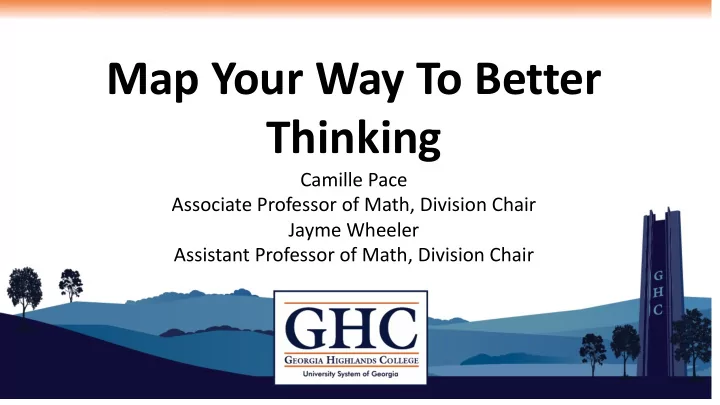

Map Your Way To Better Thinking Camille Pace Associate Professor of Math, Division Chair Jayme Wheeler Assistant Professor of Math, Division Chair
Purpose and Intent • Focus on note taking and flow charts/process maps for course design. • Students are not utilizing their homework problems or class examples where they can be used as a reference. • Developing templates for various class formats to help students complete consistent and organized work. • Based on the book "Creating Significant Learning Experiences: An Integrated Approach to Designing College Courses" by Dee Fink.
NOTE-TAKING STRATEGIES
OUTLINE- “best”, most popular, structured, • PROS • CONS • Highlights key points of lecture in • Not suitable for all subjects a logical way • Doesn’t work well if class or • Ease of use allows students to lecture does not follow a relatively focus clear structure • Give a proper and clean structure • Can be overwhelming to review to notes later
OUTLINE EXAMPLE MAIN TOPIC: HYPOTHESIS TESTING • Quantitative Data ---One Mean • z-test • Based on Normal Distribution • Shape of normal distribution is determined by population mean and population standard deviation • Used when the population standard deviation is known • t-test • Based on Student’s t-Distribution • Shape of Student’s t-Distribution is determined by number of degrees of freedom • Used when the population standard deviation is not known • Qualitative Data –Proportions • Chi-Square Goodness of Fit • Based on Chi-Square distribution • Shape of Chi-Square is determined by number of degrees of freedom • Used with qualitative (categorical) data
CORNELL (TWO-COLUMN) Great for review, unique page layout, ideal for all types of lecture or meetings • PROS • CONS • Quicker way to take, review, and • Paper needs to be prepared organize notes ahead of time • Summarizes all information • Requires some time at end for systematically summarization • Easily extract main ideas or key concepts
HYPOTHESIS TESTING Key Words Quantitative Data –One Mean -z-test z-Test –used when 𝜏 is known, based on -t-test 𝑂 𝜈, 𝜏 -Chi-square t-Test—used when 𝜏 is not known, based Goodness of Fit on 𝑢 &' , 𝑒𝑔 = 𝑜 − 1 Questions -Symbol for Chi- Qualitative Data – Proportion square goodness Chi-square Goodness of Fit ---used with of fit qualitative data, based on Chi-square - Why two goodness of fit distribution, df = k - 1 different formulas for degrees of freedom? SUMMARY: Hypothesis Testing is an important statistical analysis tool. There are different tests based on different distributions. Which test is used is determined by the type of data and parameter.
PROCESS MAPS
What are Process Maps A concept map is a visual organization and representation of knowledge. • It shows concepts and ideas and the relationships among them. • You create a concept map by writing key words (sometimes enclosed in shapes such as circles, boxes, triangles, etc.) and then drawing arrows between the ideas that are related. • Then you add a short explanation by the arrow to explain how the concepts are related.
Central Limit Theorem* A sample size is A sample size is not given given Proportions are used to create the standard deviation (use 5 places after Normal and InvNorm Normal and InvNorm decimal) and a sample size is given (Lesson 13) (Lesson 14) Normal and InvNorm for proportions Standard deviation does Standard deviation (Lesson 15) not change! changes to σ/ √𝑜 Test (n) * (p) ≥ 10 and (n) * (1 – (p)) ≥ 10 1. The scenarios will be 1. The scenarios will be If true statements, the standard deviation is less than, greater than, less than, greater between for normalcdf. /∗(23/) than, between for 5 normalcdf. 2. It will ask for a 1. The scenarios will be less than, greater percentile for the 2. It will ask for a than, between for normalcdf. InvNorm question percentile for the InvNorm question. * Always check for the assumptions for each case.
Assessing Process Maps in YOUR class • Have students submit outline or “mind map” of a particular topic/unit • Have students create a process map • Perfect for discussion activities • Excellent for merging concepts
Extra Resources https://ctl.byu.edu/tip/concept-mapping https://learningcenter.unc.edu/tips-and-tools/using-concept-maps/ https://er.educause.edu/articles/2018/3/using-process-mapping-to- redesign-the-student-experience
Questions? Camille Pace Jayme Wheeler cpace@highlands.edu jwheeler@highlands.edu
Recommend
More recommend